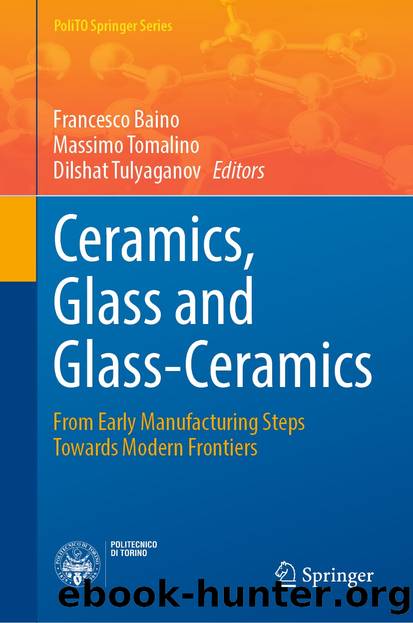Ceramics, Glass and Glass-Ceramics by Unknown

Author:Unknown
Language: eng
Format: epub
ISBN: 9783030857769
Publisher: Springer International Publishing
8 Bioactive Glass Coatings
The need for bioactive coatings is of particular interest when inert materials are implanted in the patientâs bone. In fact, after being implanted, nearly-inert ceramics (e.g. alumina) or metals are typically encapsulated within fibrous tissue without establishing a chemical bond with host bone. BG coatings have the potential to overcome this limitation as they can improve the stability of underlying implant by tightly bonding it to the host bone. Furthermore, if metallic implants are used, BGs protect the metal from corrosion and avoid the release of toxic metallic cations in vivo [105]. The glass composition, which dictates the bioactive behavior, should be carefully designed if the intended application is for coating: in fact, glasses with high bioactivity are also prove to quickly dissolve in the biological fluids, thereby causing instability of the implant lying underneath. This is probably the major reason why the use of BG coatings is still limited compared to other bioceramics, such as non-resorbable thermal-sprayed HA [106].
Another key point to consider is the mismatch between the thermal expansion coefficient (TEC) of BG and substrate. Ideally, the TEC of BG should be as close as possible to that of the substrate to prevent the glass pulling away from the implant upon thermal processing (e.g. sintering) [107]. However, the TECs of 45S5 Bioglass® (15âÃâ10â6 °Câ1) and of most of silicate BGs are significantly higher than that of titanium alloys (about 9âÃâ10â6 °Câ1), which are commonly used in orthopaedic and dental prosthetics. Therefore, a great challenge of the next few years will be the development of new BGs with more suitable TEC and dissolution rate for use as coating materials.
Conventional techniques for producing BG coatings include manual deposition or dipping followed by glass particle sintering (enameling and glazing) [108â114] and thermal spraying [115â117]. In the last years, new approaches (e.g. multilayer BG coatings to achieve a good compromise between adequate TEC, slow dissolution rate and bioactivity [118]) and fabrication methods (e.g. electrophoretic deposition [119], radio-frequency sputtering [120]) have been experimented to produce well-adherent and durable coatings on a variety of materials and implants, including scaffolds, suture wires, surgical screws and ocular implants. Composite coatings were also produced where the polymeric phase, acting as a glue, ensures a good adhesion of the coating to substrates of complex geometries [121, 122]; in this case, thermal post-processing must be avoided to preserve the organic phase. A comprehensive overview of BG coatings has been provided by Baino and Verné [123]; in this regard, a special update of that work deserves to be reported here about antiviral coatings, the potential of which became so apparent from winter 2019 in the frame of the global battle against Coronavirus SARS-CoV-2.
During the pandemic of COVID-19 caused by the new Coronavirus SARS-CoV-2, the confinement measures slowed down the contagion but did not completely avoid the disease diffusion. The individual protection equipment (e.g. facial masks) as well as the filters for air conditioning systems and medical respiratory devices do not possess an intrinsic antimicrobial/antiviral action and, thus, are susceptible to microbial/viral colonization.
Download
This site does not store any files on its server. We only index and link to content provided by other sites. Please contact the content providers to delete copyright contents if any and email us, we'll remove relevant links or contents immediately.
Tattooing the World: Pacific Designs in Print and Skin by Juniper Ellis(582)
3d drawing and optical illusions: how to draw optical illusions and 3d art step by step Guide for Kids, Teens and Students. New edition by Sophia Williams(353)
Digital Hand Lettering and Modern Calligraphy by Kim Shelly;(318)
Brain Art by Unknown(304)
The Complete Photo Guide to Hand Lettering and Calligraphy by Sy Abbey;(285)
Writing & Illuminating & Lettering by Edward Johnston(258)
Ceramics, Glass and Glass-Ceramics by Unknown(254)
Pixel Art for Beginners: Make Your Own Graphics for Games, Animations, and More by Anthony Haynes(245)
Hand Lettering Off the Page by Amy Latta(244)
Fantasy Creatures in Clay by Neal Deschain(219)
The Video Game Guide: Volume 1. 1947-1989 by Unknown(178)
Graffiti Grrlz by Jessica Nydia Pabón-Colón(172)
Origami Playtime Book 2 Toy Shop by Nobuyoshi Enomoto(158)
